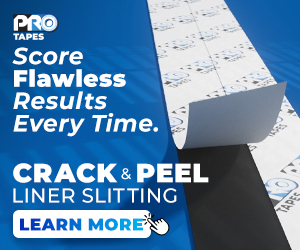Halloween Is Coming: PSA Ghosts Can Be Pretty Scary
- Published: October 01, 2002, By David J. Bentley Jr., RBS Technologies
October is an exciting month. In many areas Mother Nature creates an amazing display of colors. The weather is often ideal without the extreme hot and humid conditions of summer or the freezing temperatures and precipitation of winter. And, of course, there are the ghosts and goblins of Halloween, and that brings us to the subject of this October column: “ghosting” in the converting industry.
Ghosting in our industry is not the act of wearing a sheet on Halloween. It is instead a term used in the pressure-sensitive adhesive (PSA) field to indicate residue remaining on a surface after removing a removable p-s label.
The residue has an oily appearance and often is visible only when viewed from an angle or in a certain light. It is not particles of adhesive that transfer from the back of the label to the substrate. It is an oil, plasticizer, or low-molecular-weight additive that blooms from the removable PSA and appears on the surface of the substrate. This phenomenon may take some time to occur.
To understand the reason for ghosting, we need to know something about the composition of removable PSAs. A very common ingredient in such products is the oil, plasticizer, or low-molecular-weight additive mentioned above.
It makes the product removable by forming an oily interface between the substrate and the adhesive. This allows a consumer to remove the label material easily from the surface on which it resides. The ghosting phenomenon may not be desirable, since it does mar the surface.
How can you prevent ghosting? Unfortunately, the adhesive user generally has no control over the ghosting. The presence of the oily materials in the adhesive means they usually will migrate to a surface, especially after being on that surface for an extended time. Nothing the user can do will prevent this.
Contacting the supplier of the adhesive is often the only remedy. The supplier should be able to suggest a different adhesive or offer to reformulate the offending adhesive to eliminate the oily material.
Note that reformulation may require the addition of something else to ensure it is removable. This means extended testing will be necessary to ensure the adhesive not only does not exhibit ghosting but also remains removable. Selecting a new adhesive also will require testing for ghosting and ability to remove.
This necessity of working closely with the supplier is an excellent example of the relationships that users of adhesives, coatings, and inks need to build with their suppliers.
Only by working together in this way can they find the solutions to many problems. Each party knows only a part of the story, not enough to provide a complete answer to a question or solution to a problem. Both parties together make the story complete and lead to the necessary solution.
The next time you experience ghosting, saying boo or presenting a treat will not eliminate it. You undoubtedly need to use a different removable PSA adhesive to avoid the surface marring.
David J. Bentley Jr. is a recognized industry expert in polymers, laminations, and coatings with more than 30 years of experience in R&D and technical service. Contact him at dbentley@unm.edu.












